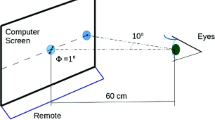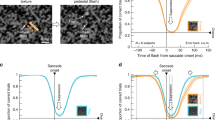Abstract
Two experiments utilized the stop signal paradigm to examine whether fixation offset and stop signal intensity influenced saccadic inhibition. There was a robust fixation offset effect on saccadic latencies. However, contrary to expectations, fixation offset did not influence saccadic inhibition latencies. Importantly, saccadic inhibition latencies were found to be influenced by stop signal salience, with a more intense signal leading to faster stopping. This pattern of results was observed whether the stop signal was presented in the visual or auditory modality. The results provide new insights into the mechanisms of inhibition and help resolve previous inconsistencies in the literature.



Similar content being viewed by others
Notes
We thank an anonymous reviewer for pointing this out.
References
Armstrong IT, Munoz DP (2003) Inhibitory control of eye movements during oculomotor countermanding in adults with attention-deficit hyperactivity disorder. Exp Brain Res 152:444–452
Asrress KN, Carpenter RHS (2001) Saccadic countermanding: a comparison of central and peripheral stop signals. Vis Res 41(20):2645–2651
Band GPH, van der Molen MW, Logan GD (2003) Horse-race model simulations of the stop-signal procedure. Acta Psychol 112:105–142
Cabel DWJ, Armstong IT, Reingold E, Munoz DP (2000) Control of saccade initiation in a countermanding task using visual and auditory stop signals. Exp Brain Res 133:431–441
Carpenter RH (2004) Contrast, probability, and saccadic latency; evidence for independence of detection and decision. Curr Biol 14:1576–1580
Cavina-Pratesi C, Bricolo E, Prior M, Marzi CA (2001) Redundancy gain in the stop-signal paradigm: Implications for the locus of coactivation in simple reaction time. J Exp Psychol Hum Percept Perform 27:932–941
Colonius H, Özyurt J, Arndt PA (2001) Countermanding saccades with auditory stop signals: testing the race model. Vis Res 41:1951–1968
Dorris MC, Munoz DP (1995) A neural correlate for the gap effect on saccadic reaction time in monkey. J Neurophysiol 73:2558–2562
Dorris MC, Pare M, Munoz DP (1997) Neuronal activity in monkey superior colliculus related to the initiation of saccadic eye movements. J Neurosci 17:8566–8579
Fendrich R, Demirel S, Danziger S (1999) The oculomotor gap effect without a foveal fixation point. Vis Res 9:833–841
Findlay JM, Walker R (1999) A model of saccade generation based on parallel processing and competitive inhibition. Behav Brain Sci 22:661–721
Forbes K, Klein RM (1996) The magnitude of the fixation offset effect with endogenously and exogenously controlled saccades. J Cogn Neurosci 8:344–352
Hanes DP, Carpenter RHS (1999) Countermanding saccades in humans. Vis Res 39:2777–2791
Hanes DP, Patterson WF, Schall JD (1998) Role of frontal eye fields in countermanding saccades: visual, movement , and fixation activity. J Neurophysiol 79:817–834
Hanes DP, Schall JD (1995) Countermanding saccades in macaque. Vis Neurosci 12:929–937
Hawkins HL, Shafto MG, Richardson D (1988) Effects of target luminance and cue validity on the latency of visual detection. Percept Psychophys 44:484–492
Hunt A, Kingstone A (2003) Inhibition of return: dissociating attentional and oculomotor components. J Exp Psychol Hum Percept Perform 29:348–354
Ito S, Stuphorn V, Brown JW, Schall JD (2003) Performance monitoring by the anterior cingulate cortex during saccade countermanding. Science 302:120–122
Kingstone A, Klein R (1993) What are human express saccades? Percept Psychophys 54:260–273
Kingstone A, Fendrich R, Wessinger CM, Reuter-Lorenz PA (1995) Are microsaccades respobsible for the gap effect? Percept Psychophys 57:796–801
Kornylo D, Dill N, Saenz M, Krauslis RJ (2003) Canceling of pursuit and saccadic eye movements in humans and monkeys. J Neurophysiol 89:2984–2999
Lappin JS, Eriksen CW (1966) Use of a delayed signal to stop a visual reaction–time response. J Exp Psychol 72(6):805–811
Logan GD (1994) On the ability to inhibit thought and action: a users’ guide to the stop signal paradigm. In: Dagenbach D, Carr TH (Eds) Inhibitory processes in attention, memory, and language. Academic, San Diego, pp 214–249
Logan GD, Cowan WB (1984) On the ability to inhibit thought and action: a theory of an act of control. Psychol Rev 91:295–327
Logan GD, Irwin DE (2000) Don’t look! Don’t touch! Inhibitory control of eye and hand movements. Psychonom Bull Rev 7(1):107–112
Morein-Zamir S, Nagelkerke P, Chua R, Franks IM, Kingstone AF (2006) Compatibility effects in stopping and response initiation in a continuous tracking task. Q J Exp Psychol (in press)
Morein-Zamir S, Nagelkerke P, Chua R, Franks IM, Kingstone AF (2006) Expectancies influence stopping and response control (submitted)
Munoz DP, Corneil BD (1995) Evidence for interactions between target selection and visual fixation for saccade generation in humans. Exp Brain Res 103:168–173
Munoz DP, Istvan PJ (1998) Lateral inhibitory interactions in the intermediate layers of the monkey superior colliculus. J Neurophysiol 79:1193–1209
Munoz DP, Wurtz RH (1993a) Fixation cells in monkey superior colliculus I. Characteristics of cell discharge. J Neurophysiol 70:559–575
Munoz DP, Wurtz RH (1993b) Fixation cells in monkey superior colliculus II. Reversible activation and deactivation. J Neurophysiol 70:576–589
Özyurt J, Colonius H, Arndt PA (2003) Countermanding saccades: evidence against independent processing of go and stop signals. Percept Psychophys 65:420–428
Pare M, Hanes HP (2003) Controlled movement processing: superior colliculus activity associated with countermanded saccades. J Neurosci 23:6480–6489
Reingold EM, Stampe DM (2002) Saccadic inhibition in voluntary and reflexive saccades. J Cogn Neurosci 14:371–388
Reuter-Lorenz PA, Hughes HC, Fendrich R (1991) The reduction of saccadic latency by prior offset of the fixation point: and analysis of the “gap effect”. Percept Psychophys 49:167–175
Ross LE, Ross SM (1980) Saccade latency and warning signals: stimulus onset, offset, and change as warning events. Percept Psychophys 27:251–257
Ross SM, Ross LE (1981) Saccade latency and warning signals: effects of auditory and visual stimulus onset and offset. Percept Psychophys 29:429–437
Saslow MG (1967) Effects of components of displacement-step stimuli upon latency for saccadic eye movement. J Opt Soc Am 57:1024–1029
Schall JD, Hanes HP, Taylor TL (2000) Neural control of behavior: countermanding eye movements. Psychol Res 63:299–307
Schall JD, Thompson KG (1999) Neural selection and control of visually guided eye movements. Annu Rev Neurosci 22:241–259
Stuphorn V, Taylor TL, Schall JD (2000) Performance monitoring by the supplementary eye field. Nature 408:857–860
Taylor TL, Kingstone A, Klein RM (1998) The disappearance of foveal and nonfoveal stimuli: Decomposing the gap effect. Can J Exp Psychol 52:192–199
Taylor TL, Klein RM, Munoz DP (1999) Saccadic performance as a function of the presence and disappearance of auditory and visual fixation stimuli. J Cogn Neurosci 11:206–213
Acknowledgments
This research was supported by grants to A.K. from NSERC, the Michael Smith Foundation of Health Research and the Human Early Learning Partnership. The authors wish to thank Jennifer Quan, Christine Yeung and for their assistance in data collection and to Stephanie Ho for her assistance in task development.
Author information
Authors and Affiliations
Corresponding author
Appendix
Appendix
To ensure that the intensity of the stop signal was sufficient to produce a behavioural change, two control studies (for Experiment 1 and Experiment 2, respectively) were conducted on separate groups of 12 participants from the same subject pool. The procedure was similar to the stop signal task. However, now participants were required to press the space bar as fast as possible in response to the stop signals while ignoring the targets appearing to the left or the right. Participants completed ten trials in each combination of the fixation offset and signal intensity conditions. In addition, ten trials (20%) were catch trials where a stop signal did not appear and thus participants were required to withhold the response. The order of trial presentation was random, with stop signals appearing randomly at 525, 575 or 625 ms following fixation onset. No eye movement data was recorded for these studies.
The results for both studies confirmed significant effects of signal intensity on manual RTs. In Experiment 1 the low intensity visual signal led to slower RTs compared to the high intensity signal (338 vs. 302 ms, respectively), F(1, 11) = 34.24, MSE = 395.88, P < 0.001. The results of Experiment 2 were similar with faster RTs for the auditory high intensity signal (419 vs. 367 ms, respectively), F(1, 11) = 12.7, MSE = 2,555.01, P < 0.01. Neither fixation condition nor the interaction reached significance in either experiment. Hence, the control studies confirmed that the two signal intensities in each experiment were sufficiently different so as to account for an observable behavioral difference.
Rights and permissions
About this article
Cite this article
Morein-Zamir, S., Kingstone, A. Fixation offset and stop signal intensity effects on saccadic countermanding: a crossmodal investigation. Exp Brain Res 175, 453–462 (2006). https://doi.org/10.1007/s00221-006-0564-x
Received:
Accepted:
Published:
Issue Date:
DOI: https://doi.org/10.1007/s00221-006-0564-x




